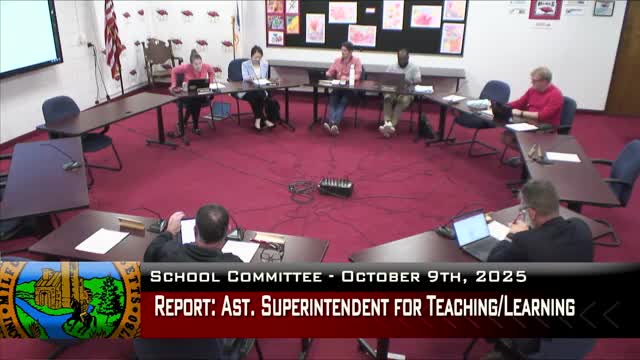Milford presents DESE accountability data; math program shows growth despite mixed MCAS outcomes
October 10, 2025 | Milford Public Schools, School Boards, Massachusetts
This article was created by AI summarizing key points discussed. AI makes mistakes, so for full details and context, please refer to the video of the full meeting. Please report any errors so we can fix them. Report an error »

The assistant superintendent for teaching and learning presented Milford Public Schools’ state accountability data from the Department of Elementary and Secondary Education (DESE) and reviewed the district’s math curriculum implementation.
The presenter summarized DESE’s five accountability components—MCAS achievement in ELA, math and science; growth in ELA and math; high‑school completion; progress toward English‑language proficiency; and additional indicators including chronic absenteeism and advanced coursework completion. She said DESE’s overall label for the district indicated the district is not requiring assistance and is “making moderate progress” toward goals.
The assistant superintendent reported that the district’s overall rating rose to 54 percent progress in 2025, up from 41 percent in 2024, noting that DESE weights the most recent year more heavily. On achievement columns she said the district received 1 point out of 4 in ELA achievement (flat), 2 of 4 in math (improved but below target) and gains in science that were still below target.
She highlighted areas of success: the district’s lowest‑performing students in grades 3–8 exceeded targets in both ELA and math, and math growth for grades 3–8 rose from an SGP of about 43.2 to roughly 52—an average gain the district characterized as meaningful. At the school level, Memorial posted notable gains (38 percent proficient, a 5‑point increase year‑to‑year) that district leaders tied to intensive classroom coaching (“fishbowl” lessons) and teacher‑leader work. Woodland (three years into Illustrative Mathematics) returned to pre‑implementation achievement levels and continues targeted classroom coaching; Stacy is showing rebound in SGP after an initial implementation dip.
The presenter said high‑school grade‑10 results declined and noted two possible contributors: the first cohort to take grade‑10 MCAS had not experienced the district’s new math curriculum in earlier grades, and the state removed the MCAS as a competency determination last year, which may have changed student incentive structures.
District staff described local assessment data as well: Brookside’s end‑of‑year i‑Ready math showed roughly 30 percent of students at or above grade level and typical growth in the mid‑90s percentile; Memorial’s i‑Ready median growth and proficiency were higher than other elementary schools. The assistant superintendent asked the committee to continue supporting curriculum leadership roles; she said the district will request funding for algebra‑2 materials in a later budget request.
Committee members asked for more clarity on DESE’s target‑setting methodology; staff said the state sets targets based on prior‑year performance and a rolling formula. The presentation closed with a call to sustain professional learning time, coaching and teacher leadership to continue progress.
The presenter summarized DESE’s five accountability components—MCAS achievement in ELA, math and science; growth in ELA and math; high‑school completion; progress toward English‑language proficiency; and additional indicators including chronic absenteeism and advanced coursework completion. She said DESE’s overall label for the district indicated the district is not requiring assistance and is “making moderate progress” toward goals.
The assistant superintendent reported that the district’s overall rating rose to 54 percent progress in 2025, up from 41 percent in 2024, noting that DESE weights the most recent year more heavily. On achievement columns she said the district received 1 point out of 4 in ELA achievement (flat), 2 of 4 in math (improved but below target) and gains in science that were still below target.
She highlighted areas of success: the district’s lowest‑performing students in grades 3–8 exceeded targets in both ELA and math, and math growth for grades 3–8 rose from an SGP of about 43.2 to roughly 52—an average gain the district characterized as meaningful. At the school level, Memorial posted notable gains (38 percent proficient, a 5‑point increase year‑to‑year) that district leaders tied to intensive classroom coaching (“fishbowl” lessons) and teacher‑leader work. Woodland (three years into Illustrative Mathematics) returned to pre‑implementation achievement levels and continues targeted classroom coaching; Stacy is showing rebound in SGP after an initial implementation dip.
The presenter said high‑school grade‑10 results declined and noted two possible contributors: the first cohort to take grade‑10 MCAS had not experienced the district’s new math curriculum in earlier grades, and the state removed the MCAS as a competency determination last year, which may have changed student incentive structures.
District staff described local assessment data as well: Brookside’s end‑of‑year i‑Ready math showed roughly 30 percent of students at or above grade level and typical growth in the mid‑90s percentile; Memorial’s i‑Ready median growth and proficiency were higher than other elementary schools. The assistant superintendent asked the committee to continue supporting curriculum leadership roles; she said the district will request funding for algebra‑2 materials in a later budget request.
Committee members asked for more clarity on DESE’s target‑setting methodology; staff said the state sets targets based on prior‑year performance and a rolling formula. The presentation closed with a call to sustain professional learning time, coaching and teacher leadership to continue progress.
View full meeting
This article is based on a recent meeting—watch the full video and explore the complete transcript for deeper insights into the discussion.
View full meeting
